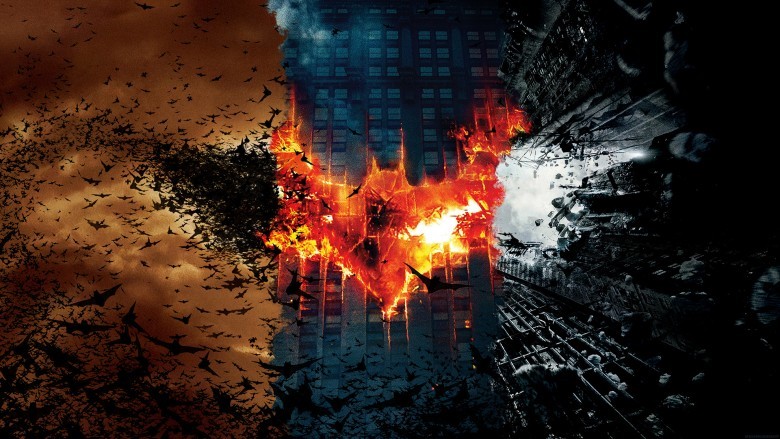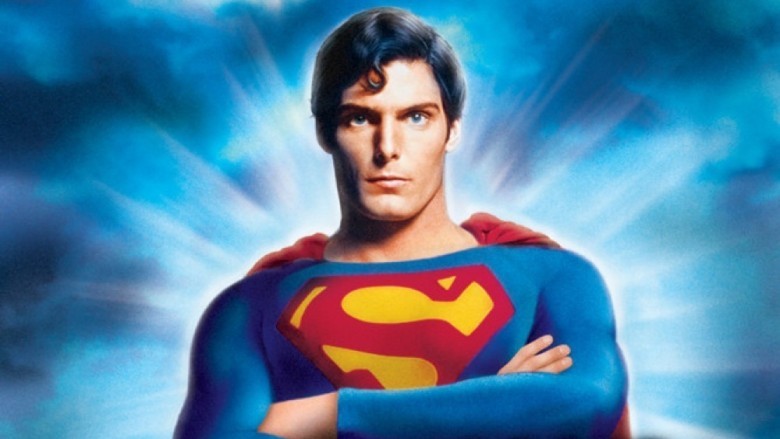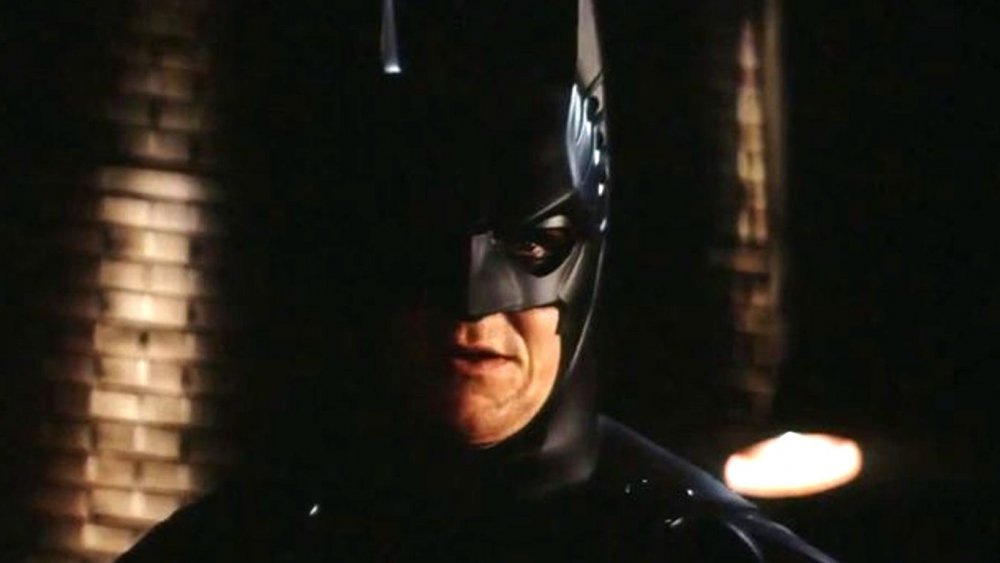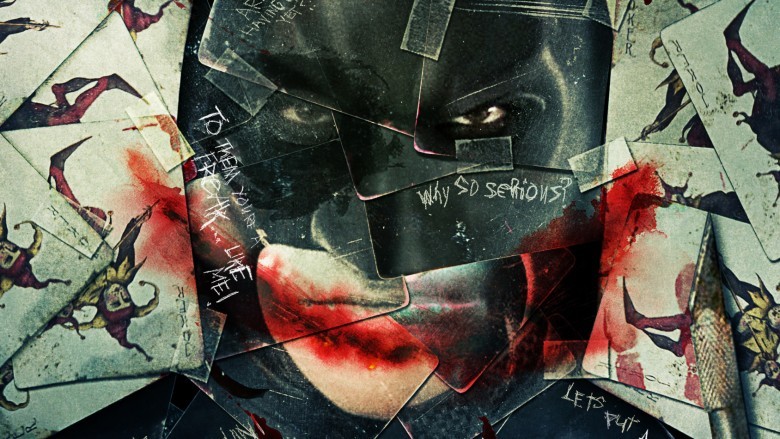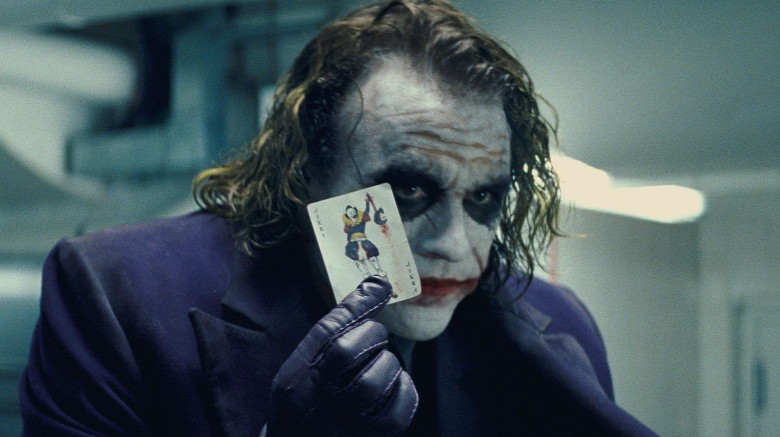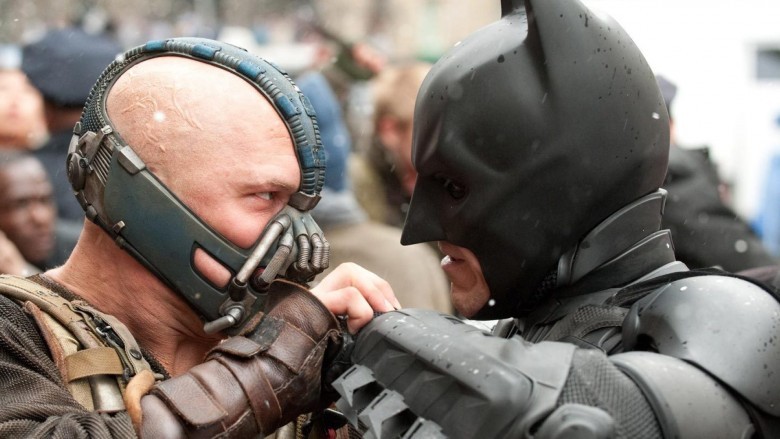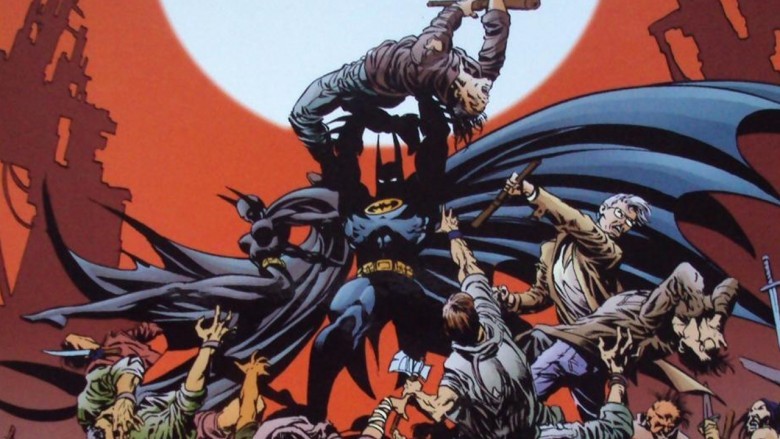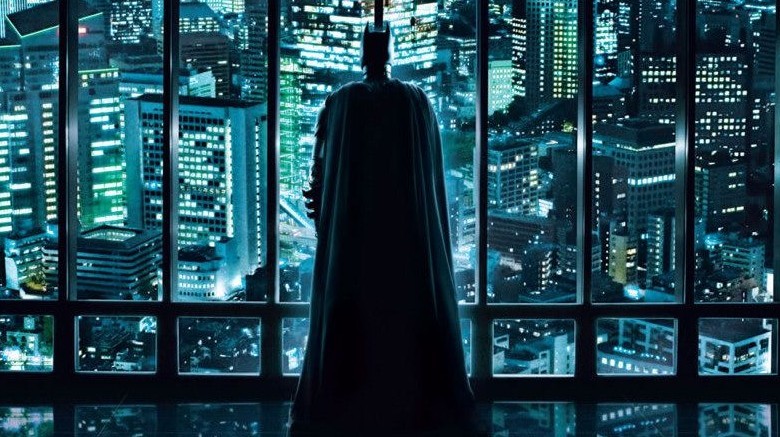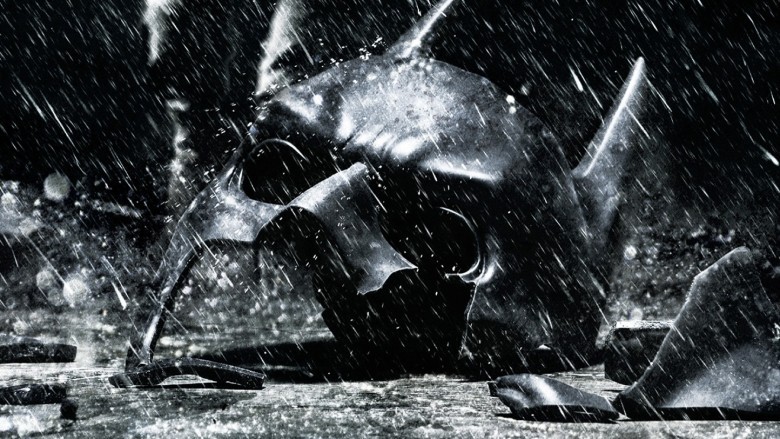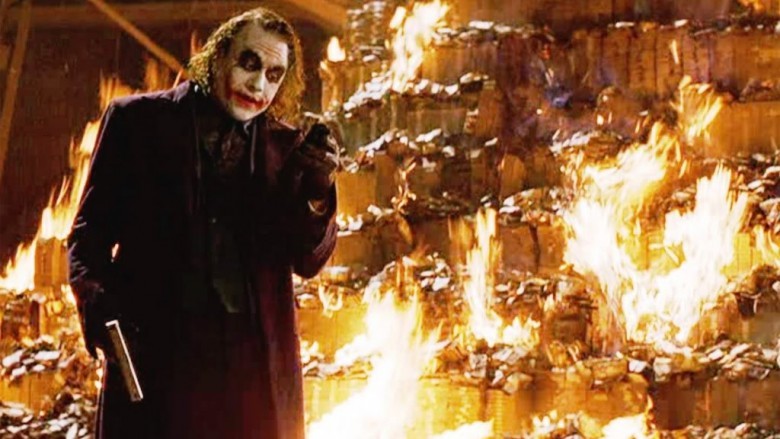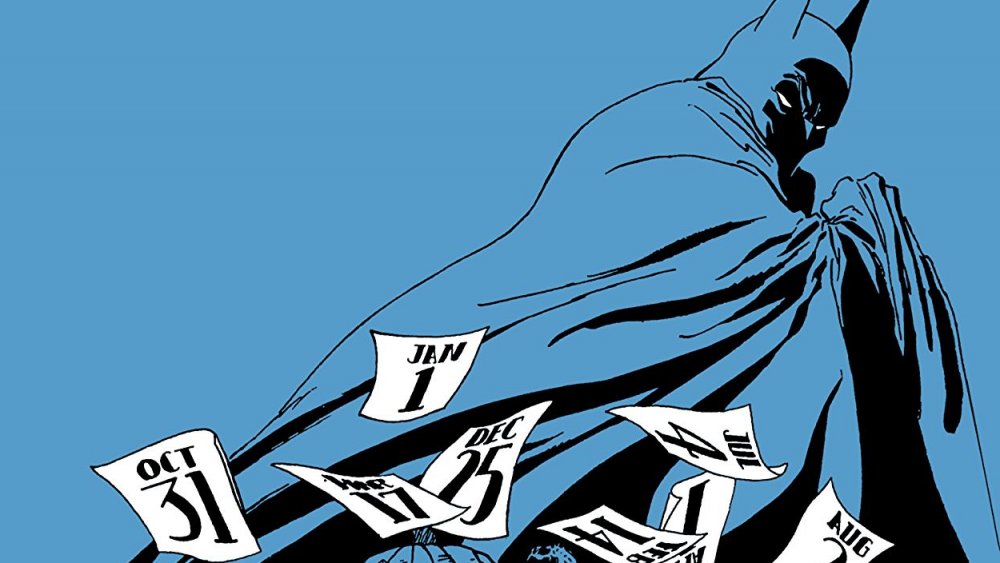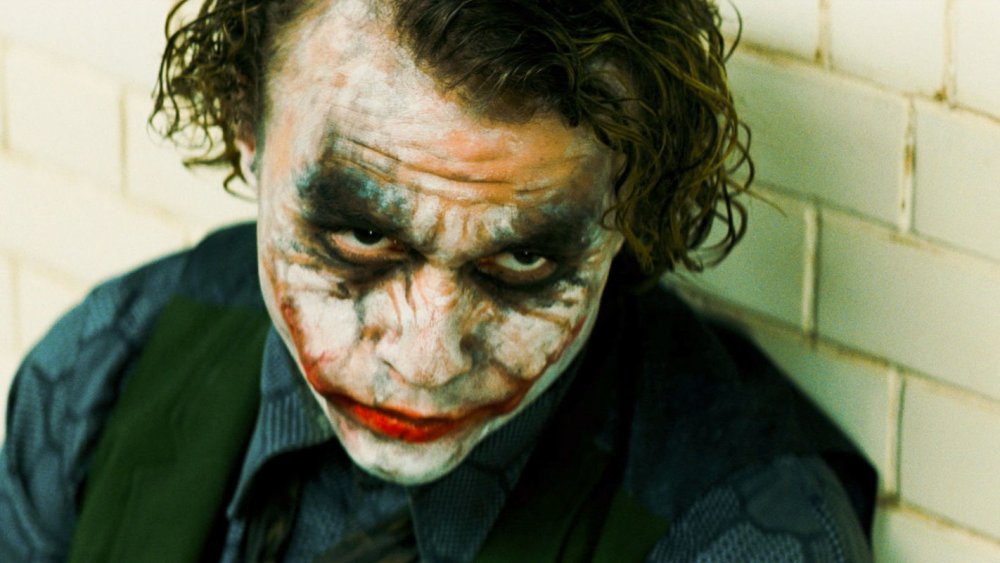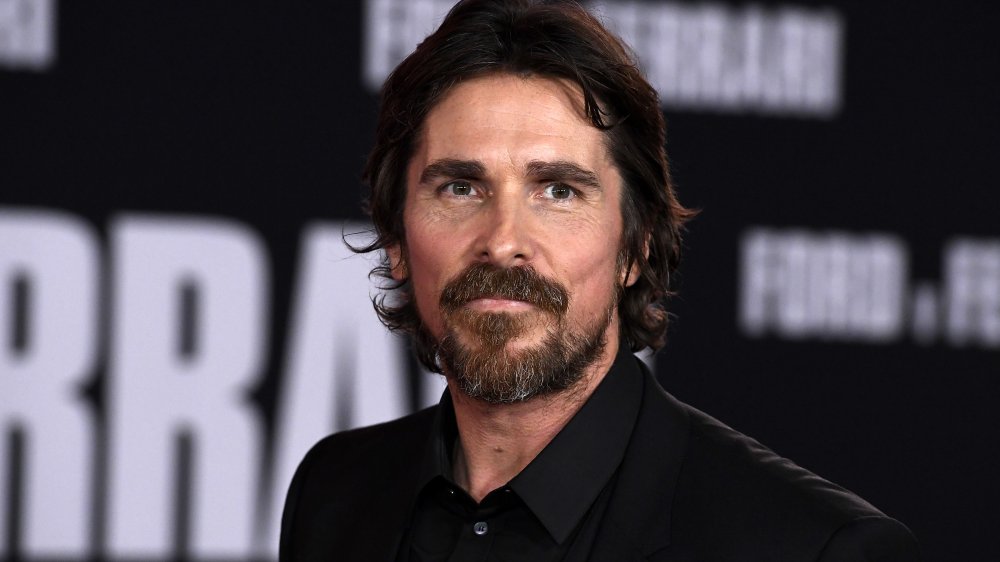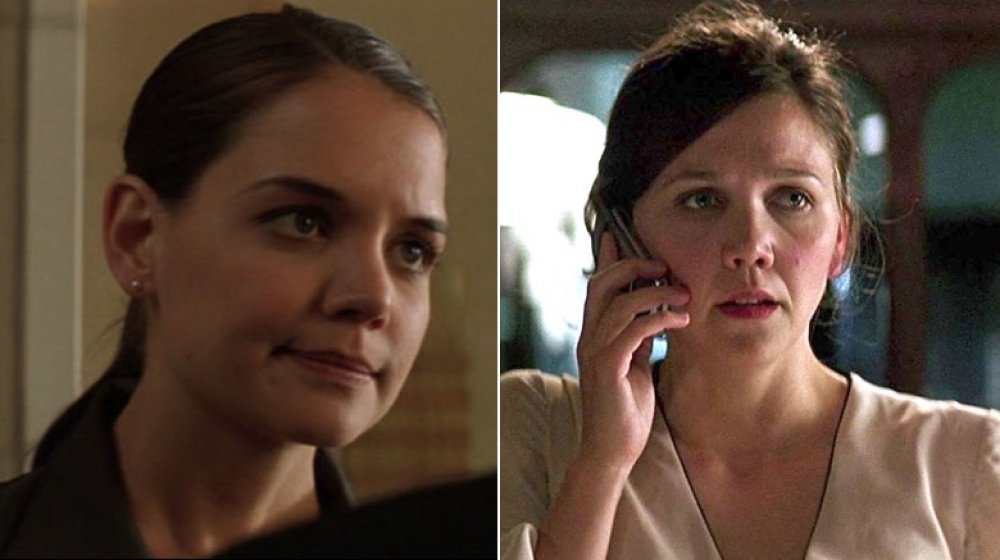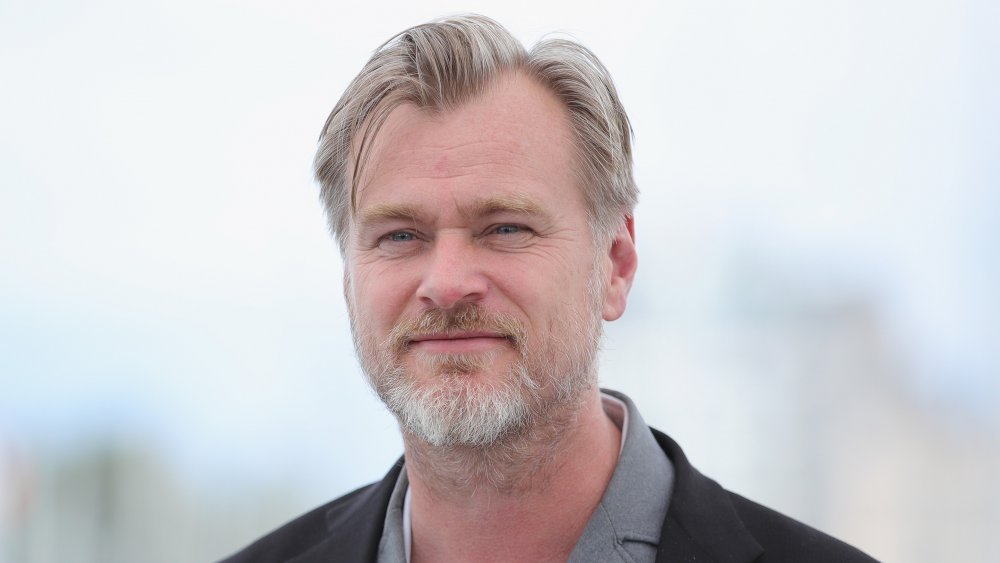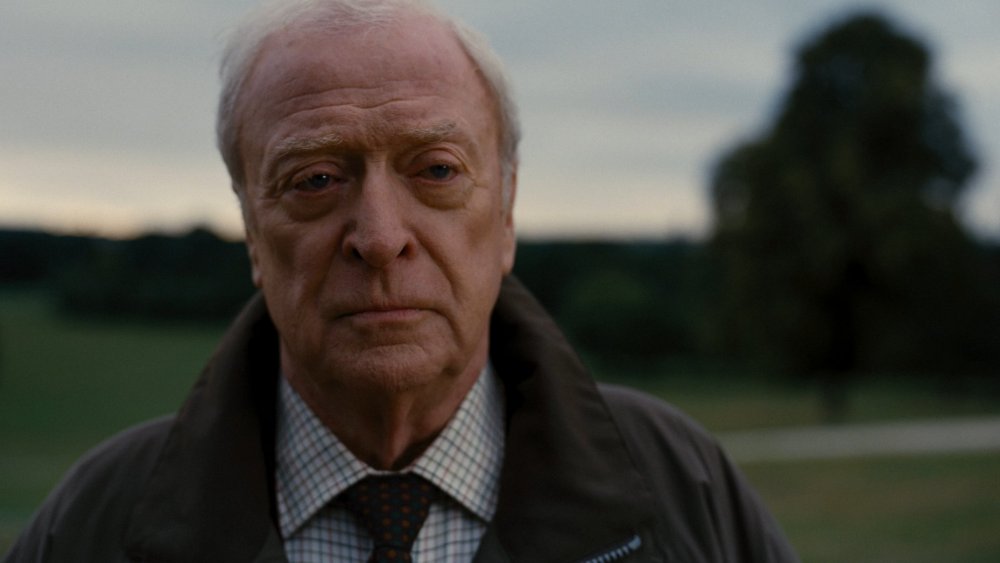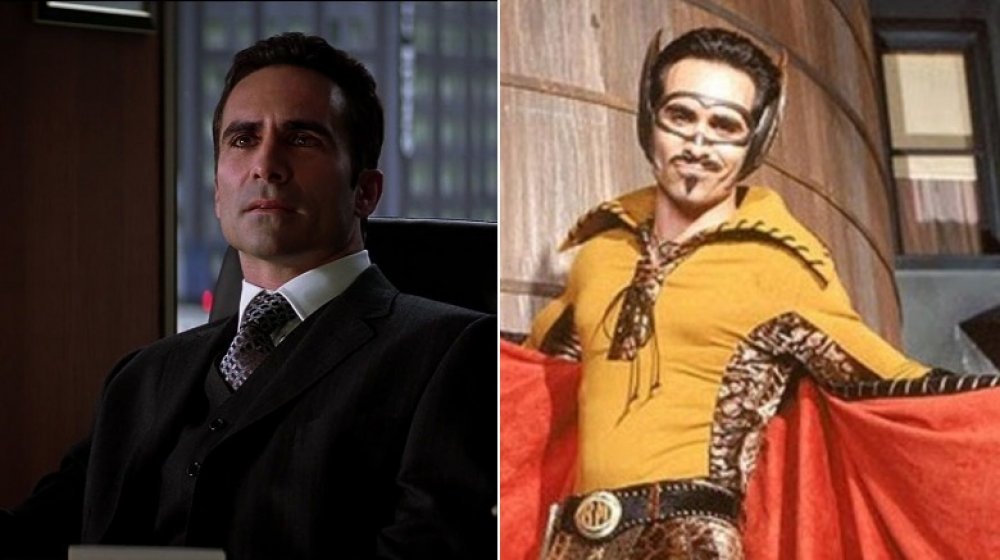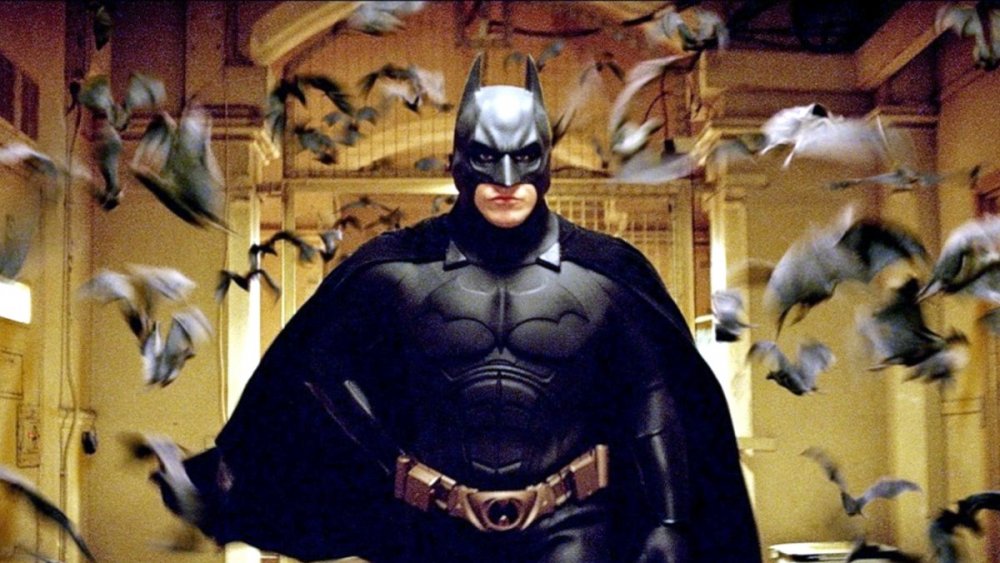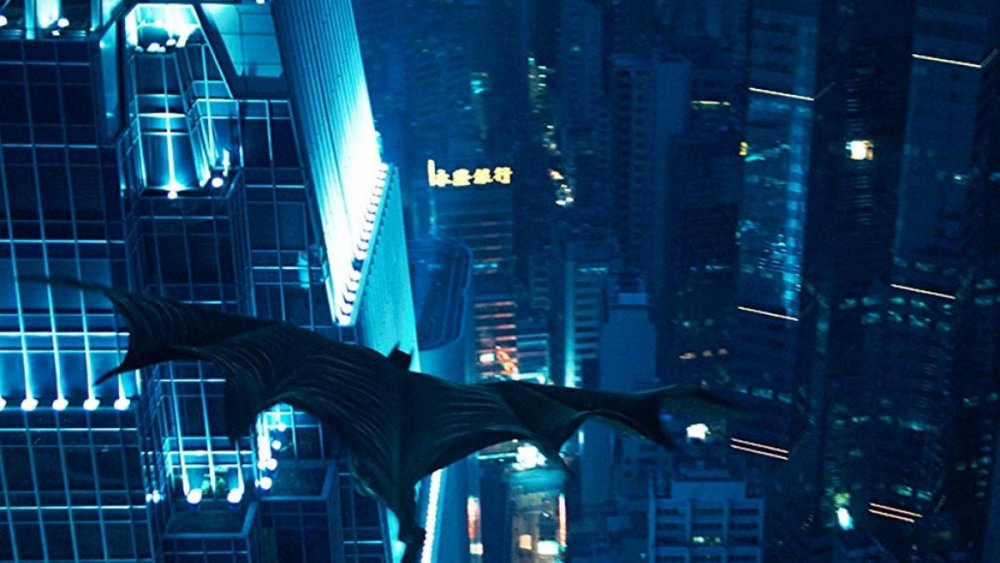The Untold Truth Of The Dark Knight Trilogy
Every actor who's ever agreed to don Batman's cowl onscreen has had some big boots to fill — and after the award-winning blockbuster success of the Dark Knight trilogy helmed by Christopher Nolan, those boots only grew a size or two bigger. We're talking, after all, about a series of films that still stands among the most critically and commercially successful entries in the superhero genre.
After all these years, it's easy to assume we've learned everything there is to know about the Dark Knight trilogy — but just like Batman himself, these movies are very good at keeping their secrets. With a little research, though — and possibly some help from a utility belt — we've uncovered the untold truth of the Dark Knight trilogy.
Batman Begins was inspired by Superman
Batman and Superman are often presented in stark opposition to one another. One is a dark figure who triumphs through technology and intimidation; the other is a bright figure who triumphs through superpowers and inspiration. This dichotomy served as the central drama underpinning the appropriately-named Batman v Superman. It might be surprising, then, to hear that Christopher Nolan's Batman actually owes quite a bit to Superman.
Nolan has said that, like many people, he was blown away by the Richard Donner Superman movie in 1978. Among its many brilliant features, he appreciated that it told the story of Superman's origin. Nolan contrasted this with Tim Burton's 1989 Batman, one in which the character is fully formed by the time the movie starts, and saw Batman Begins as his chance to do what he called "1978 Batman," a movie where he could have a setting "where the world is pretty much the world we live in but there's this extraordinary figure there" and explore the origin of the figure. While the shape of the modern DC Expanded Universe comes from the clash between Batman and Superman, Nolan's masterful trilogy could never have started without the inspiration of the big blue Boy Scout.
Christian Bale auditioned for Batman Begins in Val Kilmer's costume
One of the most notable aspects of Nolan's Dark Knight Trilogy is how much Christian Bale made the character his own. He was, after all, the fifth actor to don the costume for the big screen, and he knew it was inevitable that he'd be compared to previous Batmen. All of which makes it that much more fascinating that when Bale auditioned for the role of Batman, he did so while wearing Val Kilmer's old Batman suit.
In fact, Nolan made every prospective Batman actor wear the old suit. Why go through all the trouble? According to the director, being Batman onscreen transcended concepts such as "chemistry" or simple "acting ability." Rather, he wanted an actor who could "project this extraordinary iconography from the inside" and "to project massive energy through this costume in order to not question the costume." Another interesting note about his audition is who Bale was reading lines with: Amy Adams, who was standing in that day. Later, of course, Adams would take her own place alongside a very different Batman when she reprised her role of Lois Lane in Batman v Superman.
The Joker's plan was influenced by The Killing Joke
In the Batman Begins sequel The Dark Knight, Heath Ledger gave such a powerful and singular performance as the Joker that it's still difficult to imagine anyone else in the role — even after seeing Joaquin Phoenix play the part in Joker. Nonetheless, even Ledger's performance had its precedents: much of the Dark Knight trilogy selectively draws from comics lore, with Batman Begins cribbing heavily from Batman: Year One and Dark Knight Rises exploring variations of themes in the "No Man's Land" comics. For Dark Knight, though, one major element of the Joker is taken from The Killing Joke, written by comics legend Alan Moore.
That comic is infamous for a number of reasons. The Joker cripples Barbara Gordon and kidnaps Commissioner Gordon, taking him to a demented funhouse where he's tortured with naked images of his bleeding and crippled daughter. Why do all this? As the Joker himself says, "I've demonstrated there's no difference between me and everyone else! All it takes is one bad day to reduce the sanest man alive to lunacy. That's how far the world is from where I am. Just one bad day."
Sound familiar? It should. In Dark Knight, Ledger's Joker gives two boats (one filled with average citizens, one filled with prisoners) the capacity to blow each other up. He gambles that "when the chips are down, these... these 'civilized' people, they'll eat each other." In both cases, though, he's proven wrong: the comics Gordon retains his sanity, and the citizens and prisoners of the movie don't descend into murder.
Two-Face was almost much nastier
Without a doubt, our first glimpse of Two-Face's burned face is appropriately grisly. The amount of damage is horrifying, and it gives us a powerful glimpse of the monster he's become as he dispenses his brand of random, coin-based "justice" against those who've wronged him. Because of how utterly gross Two-Face ended up looking, it's surprising to hear Christopher Nolan admit that he was originally even more repulsive.
In an interview, Nolan characterized the final choice for Two-Face's appearance to be one of the ones least likely to disturb fans. Why is that? Call it the Uncanny Valley effect. According to Nolan, they tried "less extreme versions," and the end result was that "they were too real and more horrifying." He made the apt comparison to the Pirates of the Caribbean movies, noting that the undead of those movies were rendered via "very fanciful, very detailed visual effect" that ultimately made the imagery "more powerful and less repulsive."
No one can agree on Dark Knight's politics
It's easy to miss amidst all the butt-kicking, but The Dark Knight has deep political subtext. In between the expected scenes of swashbuckling and derring-do, Harvey and Rachel debate the role of citizen, state, and vigilante; other characters, like Lucius Fox, question how much power is too much for one man to have, while the Joker's anarchy forces us to question many of our assumptions. The Dark Knight 's politics are definitely there, in other words — but no one can agree what they are.
Some people think Batman's role as a "reluctant warrior" who wants to turn the job over to someone else makes him a stand-in for then-Vice President Dick Cheney. Other parallels to conservative administrations include Batman's willingness to hack every phone in the city to find Joker, something that seems to evoke the notion of warrantless wiretapping. At the same time, Batman is willing to destroy his privacy-violating technology and willing to walk away from his own "war on terror," which throws a wrench in the analogy.
Christopher Nolan himself has stated that the movie isn't explicitly political, but he understands where people get these ideas. For instance, some wondered if Batman's beating a captive Joker was a commentary on the so-called "enhanced interrogation techniques" of the US military, but Nolan said that all he wanted to do was explore "a paradox: how do you fight somebody who essentially thrives on aggression?" Clearly, The Dark Knight is a mirror for the politics of whoever stares into it.
Dark Knight gave Ledger sleepless nights
In all of superhero cinema, there has yet to be a performance that tops Heath Ledger's as the Joker. His work was provocative, frenzied... he seemed to embody the very chaos that his character channeled into tormenting Batman and the rest of Gotham City. What few people know, though, is that his powerful performance played a role in his tragic death.
It's well known that Ledger died of an accidental overdose — specifically, a combination of drugs meant to combat anxiety, ease pain, and help him sleep. However, it turns out that some of his restless anxiety was due to the very film he was helping bring to life. In an interview before his death, Ledger claimed that stress related to his work on The Dark Knight led to him relying on Ambien to sleep. "I couldn't stop thinking," he explained. "My body was exhausted and my mind was still going." After his death, friends said he also fought his insomnia through all-night parties. While it's impossible to know how much of this goes back to The Dark Knight, it seems clear that embodying madness personified took a toll on Ledger's health.
Dark Knight Rises took its cue from Charles Dickens
Christopher Nolan and his brother Jonathan, who co-wrote The Dark Knight Rises, admitted they were inspired by Charles Dickens' classic A Tale of Two Cities, and in retrospect, it seems a bit obvious — at the end, Commissioner Gordon even reads from the book at Bruce Wayne's funeral.
In A Tale of Two Cities, one man about to be executed, Charles Darnay, is saved when his doppelgänger Sydney Carton takes his place — but not before Carton waxes philosophic about the "beautiful city" and "brilliant people" who are "rising from this abyss." Sounds a bit like Gotham, right? Except the death ends up being more symbolic in the movie, as it's Batman who dies so Bruce Wayne can lead a happy, normal life. Furthermore, A Tale of Two Cities focuses on the promise as well as the chaos of the French Revolution, and Bane's bizarre social experiment ends up highlighting both the best and worst of humanity. Or, as Dickens famously put it, "it was the best of times, it was the worst of times."
Dark Knight Rises puts comic storylines in a blender
In addition to drawing from Dickens, The Dark Knight Rises combines several different comic storylines. It borrows one basic concept from Dark Knight Returns, in which an aging Bruce Wayne sees his city succumbing to gang violence and decides to don the cape and cowl once more. And while Bruce Wayne isn't eligible for the senior citizen discount in this movie, the earlier narrative does make a big deal of what it's like for Wayne to return to the role of hero after eight years of retirement.
The movie also brings in elements of Knightfall, the story arc in which Bane discovered who Batman really was and, after weakening him by unleashing Arkham Asylum's residents on the city, broke into Wayne Manor and broke his back. In the comics, Batman was out of commission for quite awhile, with Caped Crusader duties being taken over by the unstable character of Azrael.
The final comic inspiration was No Man's Land, a story that saw Gotham City impacted by an enormous earthquake. In response, the government (who one can only assume was just waiting for a chance to do something like this), destroyed all bridges into Gotham and prevented other access to it, declaring the entire city a "No Man's Land." Citizens can't get out, and the villains decide to take over. The movie inverts this, of course, with Bane and his crew cutting the city off, but the narrative of trying to survive in isolation (and surrounded by psychopaths) remains.
Dark Knight redefined movie marketing
Few fans of any media are quite as passionate as comics readers. That is part of what makes adapting their favorite heroes and villains into a movie so exciting and scary: filmmakers have to adapt the nature and spirit of fans' favorite characters while adding new dimensions to the source material. However, many of the most passionate Batman fans knew they were in good hands with Dark Knight well before the movie came out. Why? It had some of the most involved and insane marketing ever created.
Some of the weird marketing included skywriting numbers that fans could call, and even providing phones ostensibly left by the Joker inside unexpected places (including birthday cakes that fans had to race around the world to find). One part of the campaign involved leaving defaced Joker cards inside select comic stores, with the cards directing fans to a special Harvey Dent election website. Over time, the image of Harvey was defaced into something more like the Joker, and the website then gave fans the ability to remove individual pixels. The result after everything was removed? The world's first public image of Heath Ledger in full Joker make-up.
The list goes on. Fake Gotham City newspapers were printed and distributed, voter registration cards were mailed, and rallies were held to elect Harvey Dent. They even created fake websites, including a GCN site (Gotham City News) and a "Citizens for Batman" site to support the vigilante hero. Ultimately, the campaign won the Cannes Lions Cyber Grand Prix Award and the Cannes Lions Silver Cyber Award.
Dark Knight Rises was impacted by a real-life villain
The death of Heath Ledger is, sadly, not the only tragedy associated with the Dark Knight movies. In 2012, a midnight screening of The Dark Knight Rises was disrupted by a gunman who ended up killing 12 people as part of a premeditated mass shooting. Apparently, the choice of which movie to strike was not a coincidence, as the shooter described himself to at least one federal official as "The Joker," which was ostensibly tied to his decision to dye his hair into a bright and unnatural color (though his was bright red rather than green).
The effects of this shooting rippled outward. In addition to becoming part of the national dialogue about gun control, the shooting prompted Warner Bros. to cancel the film's Paris premiere and caused police across the nation to view movie theaters as potential venues for more of such terrorism. Several stars canceled promotional events out of respect for the dead. Overall, the grisly affair turned into a stark reminder of the kind of real-world troubles that many fans flock to comics and movies in order to escape.
The trilogy almost never existed
It's tough at this point to imagine a world without Nolan's trilogy. However, before he brought that world into focus with Batman Begins, there were a number of false starts while Warners spent a decade trying to figure out where they wanted to take the franchise. An explicit live-action adaptation of The Dark Knight Returns was scrapped, and Batman: Year One was nearly adapted twice (more on that in a minute). Amusingly, one of these scrapped movies included Batman vs. Superman, which very nearly came out in 2004 and may, according to the rumor mill, have had Christian Bale attached.
Perhaps the weirdest movie planned was the studio's second stab at an adaptation of Batman: Year One. It would have been directed by Darren Aronofsky, famous for movies such as Requiem for a Dream, with a screenplay by Aronofsky and Batman writer Frank Miller. In the story, Bruce Wayne is a poor kid taken in and raised by a mechanic on the wrong side of the tracks. He becomes an unhinged vigilante in the style of Taxi Driver's Travis Bickle; the story also features Selina Kyle as a black prostitute as well as an unhinged, violent, and somewhat suicidal Jim Gordon. Our first view of Gordon would have been of him sitting on the toilet with his gun and preparing to kill himself.
Fortunately, the only trigger pulled was one that killed this project, paving the way for our familiar Dark Knight trilogy to unfold.
The Dark Knight was also heavily influenced by The Long Halloween
One series often forgotten in discussions of The Dark Knight – a shame considering how heavily it contributes to the film — is the 1996-97 miniseries Batman: The Long Halloween.
The miniseries unfolds over the course of a year early in Batman's career. Batman, James Gordon, and Harvey Dent (still unscarred at this point) form an alliance to take down Gotham's organized crime. The first issue ends on Halloween night, when Batman and Dent find where the mob's secret cash storage and burn it to the ground. The Dark Knight gives us a nod to this scene when the Joker burns huge stacks of cash in the belly of a ship. By the end of the miniseries it's clear it's clear a new kind of criminal has risen in Gotham to replace the mob. In the final issue, almost all of Batman's more well-known villains unite in a final assault on mob boss Sal Maroni's home. It's Two-Face who eventually murders Maroni, just as he does in The Dark Knight.
We hear echoes of this shift from mobster to supervillain in The Dark Knight, particularly during the interrogation scene when Joker talks about how Batman has changed Gotham. It's implied in both the movie and in The Long Halloween that it's Batman's very existence that attracts the villains. Also, like Long Halloween, The Dark Knight begins with a healthy, idealistic Harvey Dent and ends with Two-Face.
Heath Ledger took real beatings filming The Dark Knight
At this point the psychological toll playing the Joker took on the late Heath Ledger is well known, and it's possible it contributed to his early death. What you may not know is that the pains Ledger took to become the Joker weren't just psychological.
Months before Ledger's death, Christian Bale praised his co-star's commitment to his role during an interview with The Hollywood Reporter. Referencing the scene when Batman confronts Joker in the GCPD interrogation room, Bale told THR that Ledger insisted that Bale hit him for real.
"I was saying, 'You know what, I really don't need to actually hit you. It's going to look just as good if I don't,'" Bale told THR, but Ledger kept "egging" him on.
Apparently, the physical punishment didn't end with the beating Ledger took. Bale went on to describe Ledger "slamming himself around, and there were tiled walls inside of that set which were cracked and dented from him hurling himself into them."
Christian Bale said no to a fourth Dark Knight film
It November 2019, Christian Bale revealed he was given the chance to do a fourth Dark Knight film, but he and Christopher Nolan apparently gave it a pass because it would've been "overindulgent."
Bale told The Toronto Sun it had always been writer/director Christopher Nolan's plan to do, at most, three Batman films — "Then when [Warner Bros.] inevitably came to us and said, 'How about a No. 4?' I said, 'No. We have to stick to [Christopher Nolan's] dream, which was always to, hopefully, do a trilogy. Let's not stretch too far and become overindulgent and go for a fourth. That's why we, well Chris, stepped away."
The former Batman actor made it clear that Nolan found it important to not focus on making a trilogy, but making one film at a time. "That's something that Chris always would talk about. He'd say, 'This is it. We're making one film. That's all we've got.' Then when [Warner Bros.] came and said, 'You want to go make another?' It was fantastic, but we still said, 'This is it. We will not get another opportunity.'"
It may be for the best that Nolan and Bale stuck to their guns. After all, the fourth entry of the Burton/Schumacher Batman saga was 1997's Batman & Robin, and we all know how that worked out.
Katie Holmes stepped away from the trilogy willingly
Throughout the Dark Knight trilogy, the most noticeable casting change is seen in Bruce Wayne's old friend and love interest Rachel Dawes. Created specifically for the Dark Knight trilogy and not appearing in the comics, Dawes is played by Katie Holmes in Batman Begins but is replaced by Maggie Gyllenhaal in The Dark Knight. The change led to speculation that Holmes — whose performance wasn't met with enthusiastic reviews — was the victim of harsh critics. Christopher Nolan denied this, saying Holmes "wasn't available" for The Dark Knight. It took eight years, but Holmes finally broke her silence about it to confirm her absence in The Dark Knight was her own choice.
Speaking to Business Insider in 2016 about her directorial debut All We Had, Holmes said not returning "was a decision that I made at that time and it was right for me at that moment, so I don't have any regrets. I think that Maggie [Gyllenhaal] did a wonderful job. But I really hope that I get to work with [Christopher Nolan] some day." Holmes didn't explain why it was the "right" decision, but at least we know the decision was hers.
Gyllenhaal wanted to be sure, too. She reportedly reached out to Holmes to ask for her blessing before giving a firm yes to replacing her as Rachel Dawes.
Christopher Nolan was extremely secretive about the Dark Knight films
Christopher Nolan is known for going to great lengths to keep plot points of his films secret, and the Dark Knight trilogy was no exception.
How does Nolan achieve this level of secrecy? Well, apparently he tells his actors the bare minimum they need to know. Ask Liam Neeson. He tapped Neeson to reprise his role as Ra's al Ghul for a cameo in 2012's Dark Knight Rises — and apparently told the actor absolutely nothing about the film.
"I can tell you nothing about Dark Knight Rises, seriously." Neeson said during the lead up to the film. "I was on set for maybe an hour-and-a-half and the director didn't tell me anything of what it's about. So, I'm being very honest when I say I have no idea what's going to happen."
Neeson may have only had a small part in Dark Knight Rises but, as the butler Alfred Pennyworth, Michael Caine was a significant part of Batman Begins and he got similar treatment when asked to appear. Caine said that Nolan appeared at Caine's door personally with a Batman Begins script to ask him if he was interested in playing Alfred, that Nolan sat while Caine read the script, and then took it with him when he left.
Michael Caine almost said no to the role of Alfred
Over the years, a handful of actors have given us memorable performances as Alfred Pennyworth. While tastes will always differ, you'd have a rough time arguing that anyone has done a better job of embodying Alfred than Michael Caine. The actor gave us an Alfred who would go to any lengths to support Bruce Wayne's efforts to save Gotham, while at the same time desperately wanting nothing more than for Wayne to give up the cowl and cape so he can find some true contentment. Surprisingly, it came close to not happening.
In fact, Caine has admitted that when he was initially approached about the role of Alfred, he was not at all enthused: "I thought that wasn't a very good part. I'll be saying, 'Dinner is served' and, 'Would you like a coffee?'" Presumably, Caine was thinking of previous versions of the character, like the late Michael Gough of the Burton/Schumacher films (whose portrayal of the character showed no signs of ever hunting jewel thieves in the jungles of Burma) or perhaps even the Alan Napier version from the '60s Batman TV show.
Thankfully, Caine learned Nolan had bigger plans for his character, although his early hesitation became a running joke between him and Nolan. He told HuffPost that in 2011 Nolan sent him a Christmas present: a dinner gong with "dinner is served" engraved on it.
The town of Batman, Turkey tried to sue Warner Bros.
One enduring superhero trope is the the hero having to fight some kind of reflection of himself — sometimes a twisted copy, like Superman's Bizarro. Well, shortly after the release of The Dark Knight, Batman called out... Batman.
In November 2008, Variety reported that the town of Batman, Turkey was suing Christopher Nolan and Warner Bros. for using the town name without permission. There was no explanation as to why then-Batman Mayor Huseyin Kalkan was not also suing DC Comics, Tim Burton, Joel Schumacher, or anyone involved in the numerous Batman television shows, movies, and animated series over the years. However, Kalkan did level some ridiculous-sounding charges at The Dark Knight, including blaming its influence for unsolved murders in the area as well as an unusually large number of suicides by young women.
There's no word on the outcome of the mayor's efforts, though we have a tough time believing we wouldn't have heard something if the lawsuit went anywhere significant. In August 2018, an online petition surfaced asking that the borders of Batman, Turkey be altered to the shape of the Batman logo; the latest figures show a little over 26,000 petitioners giving their approval to the idea.
The mayor of Gotham was used to playing a different Batman
Nestor Carbonell, who appears as the Mayor of Gotham in both The Dark Knight and The Dark Knight Rises, has a singular distinction in the Dark Knight trilogy — like Christian Bale, he also played Batman... kind of. Not really, but sort of.
Before the Dark Knight trilogy, there was the Fox Network's 2001-02 live action version of The Tick, based on the superhero spoof comic of the same name by Ben Edlund. Among the titular heroes allies was Batmanuel, played by Carbonell. Like Batman, Batmanuel doesn't appear to have any kind of super powers. Unlike Batman, Batmanuel also doesn't seem to have any other abilities that make him good at fighting crime. We don't see much of Batmanuel's crimefighting skills in the short-lived series, but among other things, we see him get beaten up by car thieves, and at one point when his "Manuel Mobile" is in the shot, he gets mugged on the subway.
As far as we know, there were no plans of the Mayor of Gotham revealing he was secretly planning to become a caped crusader like Batman, and that's probably the best choice for everybody.
Christian Bale found the Batsuit literally suffocating
You may recall the scene toward the beginning of The Dark Knight when Bruce Wayne goes to Lucius Fox for upgrades to the Bat suit. Fox responds to Wayne, "You want to be able to move your head." Which, you know, you'd think would be a fairly small ask, right? If you're constantly fighting crowds of criminals and ninjas, you should be able to move your head. No, the 1989 Batman hero couldn't do it, but this is the 21st century, for Pete's sake. So it may surprise you to learn that there's another very basic function that Christian Bale's Bat suit didn't often allow him to do – breathe.
"When it gets cold the cowl is extremely tight," Bale explained. He went on to describe what he would go through: "[A]fter a couple of takes I was trying to breathe properly in my nose. I was starting to see stars and I said 'I have to take this off'."
Bale said this was a bigger problem during the production of Batman Begins, but not so much for The Dark Knight Rises. "Thank God on this one I can [take the cowl off] — on Batman Begins I couldn't — so I had to get inside because I couldn't let anybody see me without the cowl."
Dark Knight's Hong Kong scene caused more controversy than you know
In The Dark Knight Batman's time in Hong Kong isn't that long, but it's arguably the most controversial sequence of the entire film.
In late 2007, Christopher Nolan denied reports that he changed The Dark Knight because of Hong Kong water pollution. An unnamed member of the production team had said that originally Batman was supposed to jump out of an airplane into Hong Kong's Victoria Harbor, but that this was changed when the team tested the water and found nasty stuff like "salmonella and tuberculosis." The following week Nolan said he was the one who changed the script, but that it had nothing to do with water pollution. "It was simply a script decision." Nolan said, quipping, "As far as the pollution question goes, I honestly have no problem dumping movie stars in it."
A little over a year later, Warner Bros. announced The Dark Knight would not screen in China and that they hadn't even submitted the film to government censors for consideration because of what the studio called "prerelease conditions" and "cultural sensitivities." The studio didn't elaborate, but the issues in question are widely believed to revolve around the Hong Kong sequence. There's the simple fact that it involves a Chinese money launderer, and then there's the cameo from Edison Chen — a Hong Kong singer who at the time was embroiled in a scandal involving sexually explicit photos leaked on the web.
